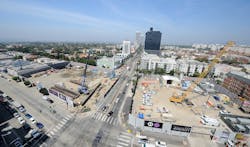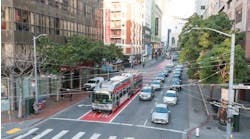The Los Angeles County Metropolitan Transportation Authority (Metro) Purple Line is one of the most important transportation projects being built in Los Angeles County, said Dennis Mori, executive officer, project management. Wilshire Boulevard is very congested and this line will allow people to travel between Westwood and downtown Los Angeles in 25 minutes. It will connect two of the biggest employment areas of Los Angeles County.
Mori said, “If you look at Wilshire Boulevard, it’s a parking lot ... to do that in 25 minutes? It’s going to be a much faster way to get to the two biggest employment."
The project was approved by the board as a 9-mile project; it’s being constructed in three sections. The overall project budget is $3.15 billion.
The initial section is approximately 4 miles and there are three underground stations. Two of the stations are in the city of Los Angeles and the third station is in the city of Beverly Hills. There are also twin bored tunnels.
The design-build contract for this section is approximately $1.7 billion and the design builder is a joint venture of Skanska | Traylor | Shea. Mori said they’re about 16 months into the contract and are a very important milestone. It’s about 85 percent complete with the design part but the first station design, Wilshire/La Brea, is essentially complete so they are starting the deck installation along Wilshire Boulevard.
Similar to other recent projects that Metro is building, they are using cut and cover construction, said Mori. It minimizes disruption to the traffic and businesses in the residential communities.
After putting in beams to support essentially what looks like a parking garage deck with concrete panels, it will cover the excavation site, which is approximately 1,000 feet long, 75 feet wide and about 70 feet deep. Traffic can continue along the decking on the street while they excavate the majority of the station underneath.
Mori said they’re scheduled for 22 consecutive weekends for this initial decking process, so they anticipate this work will be complete in November. “It’s a very important milestone at this point because in that sense, it starts the real station construction at Wilshire/La Brea,” he explained.
Contractor Selection
When the project was awarded to the contractor, they were looking at a best value design build selection process delivery method and this contractor was able to show a schedule that had a lot of efficiencies. The contractor and team had also done similar work in the city of Los Angeles, so they were able to demonstrate their knowledge of how to reduce traffic impacts and to deal with utilities and other typical challenges.
Mori said, “Over the past 16 months … they’re actually a little bit ahead of schedule in terms of coordination they’ve been doing with the city of Los Angeles utility companies.” He added, “It’s strengthening our confidence that they can meet this earlier schedule.”
With a project of this magnitude, Mori said normally this far along in a project – nearly a year and a half out – you start to see cost growth because of scope creep. With the $1.78 billion contract they’ve only seen about $1 million worth of actual changes from things that are different. “I want to qualify that by saying at the time of award, we had an option that was exercised, an award for $3.1 million. But, aside from that, which was planned, we have very minimal changes,” he said.
“That gives us a lot of confidence that with the design at about 85 percent complete, we’re not going to see any further changes since it’s design build. Things have gone very smoothly, we’ll keep our fingers crossed.”
He said their project delivery method is occurring faster than the typical design-bid-build method and they’re hoping it will bring their construction projects in earlier and provide transportation services to the public sooner.
The revenue service date is October 31, 2024 and right now, based on the progress they’ve made at the beginning of this project and the minimum amount of changes experienced, Mori said the current forecast is to compete it approximately a year earlier than that.


